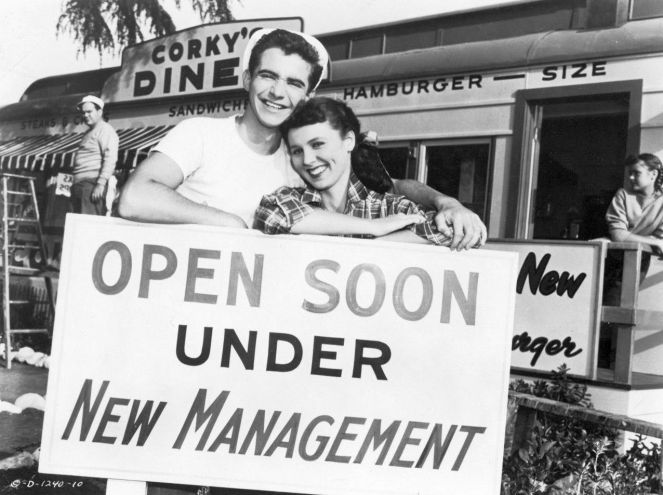
This November 24, the longest running comic strip currently being published in the United States will celebrate its centennial birthday. Technically, Gasoline Alley is the second-longest running strip of all time; the champion remains The Katzenjammer Kids, who enjoyed a staggering 109-year run in “the funny papers” (1897-2006) and is still in syndication today (though the strips are repeats, of course). (In third place: Ripley’s Believe It or Not—which is only about a month younger than Gasoline Alley.)

The above strip is a recent one from September 13, 2018; the current continuity is revisiting the origin of Alley, which began as a one-panel strip in 1918 as four car enthusiasts—Doc Smartley, Avery, Bill, and Walter Weatherby Wallet (who would become Alley’s chief protagonist)—held forth weekly on automobiles (hence the strip’s name). Gasoline Alley began to attract an audience wide enough to warrant a daily strip beginning August 24, 1919, and after two years of a growing readership Captain Joseph Patterson (editor of The Chicago Tribune) suggested to Alley’s cartoonist, Frank O. King, that introducing a baby into the story would increase the interest of women in the strip.
The drawback was that Walt Wallet was a bachelor…but this situation soon righted itself when Walt found an orphan abandoned on his doorstep in the February 14, 1921 installment (Valentine’s Day!). Wallet took the child in, named him “Skeezix” (cowboy slang for a motherless calf), and in an unassuming way, changed comic strip history by becoming one of the first (if not the first) that allowed its characters (with a few exceptions) to age normally. Walt, for example, is over a century old (118 years young) while his boy Skeezix is pushing the centennial mark.
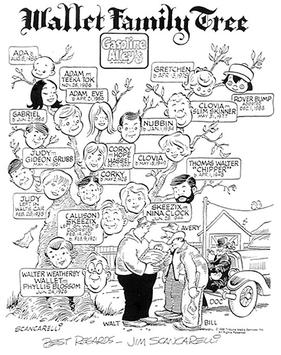 Walt Wallet would eventually face his life sentence at the altar by marrying Phyllis Blossom on June 24, 1926 (Phyllis’ death in the strip in 2004 is still a controversy among fans today) and the couple would later add two more kids to their brood: son Corky (born May 2, 1928) and daughter Judy (found in Walt’s car on February 28, 1935 and “redopted” not long after). Skeezix, Corky, and Judy would also tie the knot (not to each other, of course) and have kids in the course of the strip, which had by that time become a soap opera-like continuity with an emphasis on family humor. King, Gasoline Alley’s creator, stayed with the strip until 1959 when his assistant Dick Moores took over (King’s other assistant, Bill Perry, had been drawing the Sunday version of Alley since 1951 and continued to do so until his retirement in 1975). During Moores’ tenure with the strip in the 70s/80s, the aging process of the characters stalled briefly but picked up again when current cartoonist Jim Scancarelli took over for Moores after Dick passed away in 1986.
Walt Wallet would eventually face his life sentence at the altar by marrying Phyllis Blossom on June 24, 1926 (Phyllis’ death in the strip in 2004 is still a controversy among fans today) and the couple would later add two more kids to their brood: son Corky (born May 2, 1928) and daughter Judy (found in Walt’s car on February 28, 1935 and “redopted” not long after). Skeezix, Corky, and Judy would also tie the knot (not to each other, of course) and have kids in the course of the strip, which had by that time become a soap opera-like continuity with an emphasis on family humor. King, Gasoline Alley’s creator, stayed with the strip until 1959 when his assistant Dick Moores took over (King’s other assistant, Bill Perry, had been drawing the Sunday version of Alley since 1951 and continued to do so until his retirement in 1975). During Moores’ tenure with the strip in the 70s/80s, the aging process of the characters stalled briefly but picked up again when current cartoonist Jim Scancarelli took over for Moores after Dick passed away in 1986.
Reading Gasoline Alley has become kind of a habit with me. It’s certainly not a hilariously funny strip, but one of those features that’s become so familiar and so cozy (like a favorite pair of sneakers) that I’m powerless to resist its charms. I’m a fan of Scancarelli’s because he often includes old-time radio references in the strip (this past Sunday strip features an old nemesis of Jack Benny’s) and the current continuity (the residents of the “Old Comic Strip Retirement Home” are toasting Gasoline Alley’s upcoming centennial) allows fans of the funnies to revisit old favorites like Mutt and Jeff (you might have noticed them in the strip above) and Jiggs of Bringing Up Father.
If you were a fan of Gasoline Alley back in the day, you could also tune in to the Wallet family’s adventures on radio; there was a version broadcast over NBC in 1941 (and reports of an earlier regional show a decade earlier), and a syndicated version distributed between 1948 and 1949. The popularity of the strip even lent itself to a brief feature film franchise from Columbia in 1951 when the studio, looking to replace its long-running Blondie series (it came to an end the previous year), purchased the rights to the strip with the intention of producing an equally popular franchise.
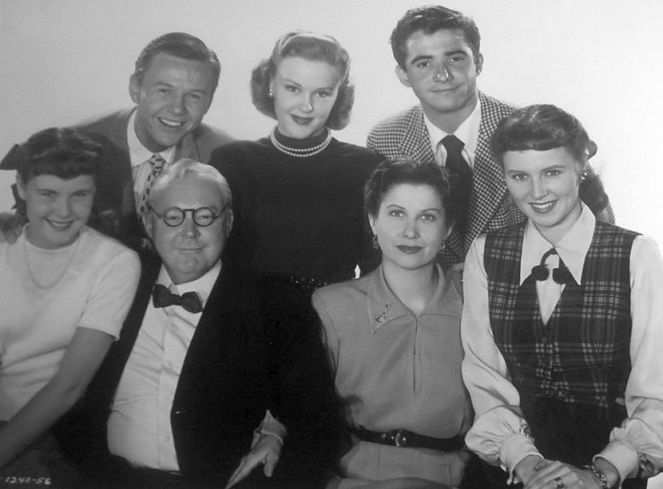
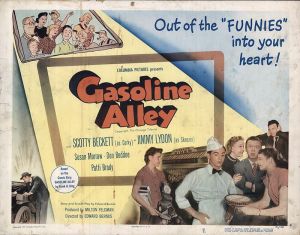 In Gasoline Alley (1951), the audience gets a little primer in the history of the strip before introducing the movie’s chief character, Corky Wallet (Scotty Beckett), who arrives home to announce that he’s newly married to bride Hope (Susan Morrow)…and a college dropout. Father Walt (Don Beddoe) and brother Skeezix (Jimmy Lydon) offer to help Corky get a footing in the world with job offers (Walt with his firm, Skeezix at his fix-it shop) but the independent Corky vows to make good on his own. He gets a modeling job at first (where he meets a young woman named Carol Rice [Virginia Toland]…much to the displeasure of Mrs. W), and then moves on to washing dishes in a restaurant. Neither job is particularly satisfying, but the dishwashing gig leads Corky to an interest in a rundown diner that he’s certain he can turn into a success with the help of his pal Pudge McKay (Dick Wessel). It’s rough sledding at first—a rival drive-in franchise wants to close Corky down and open up another restaurant in its place—but by the end of Alley’s 76-minute running time, it looks as if “Corky’s Diner” is going to be in business for a long time.
In Gasoline Alley (1951), the audience gets a little primer in the history of the strip before introducing the movie’s chief character, Corky Wallet (Scotty Beckett), who arrives home to announce that he’s newly married to bride Hope (Susan Morrow)…and a college dropout. Father Walt (Don Beddoe) and brother Skeezix (Jimmy Lydon) offer to help Corky get a footing in the world with job offers (Walt with his firm, Skeezix at his fix-it shop) but the independent Corky vows to make good on his own. He gets a modeling job at first (where he meets a young woman named Carol Rice [Virginia Toland]…much to the displeasure of Mrs. W), and then moves on to washing dishes in a restaurant. Neither job is particularly satisfying, but the dishwashing gig leads Corky to an interest in a rundown diner that he’s certain he can turn into a success with the help of his pal Pudge McKay (Dick Wessel). It’s rough sledding at first—a rival drive-in franchise wants to close Corky down and open up another restaurant in its place—but by the end of Alley’s 76-minute running time, it looks as if “Corky’s Diner” is going to be in business for a long time.
There are some small differences between the Alley strip and the first feature: Walt ran a successful furniture company (Wicker & Wallet) for many years in the comics but appears to be a Dagwood Bumstead-like office drone in Gasoline Alley…while Skeezix owned and operated a garage in the comic strip version (his “fix-it shop” plays an integral role in the second Alley film). (Also, the details of Judy’s “redoption” are abandoned.) Other than those tiny nitpicks, Gasoline Alley is a fun little film that captures the flavor of the strip fairly well; Don Beddoe’s make-up makes him a dead ringer for Walt (Beddoe was a long-standing Columbia player, and appears in a few of the Blondie films as “Marvin Williams”) and I always enjoy seeing Jimmy Lydon (who starred in the Henry Aldrich movies made at Paramount). I only wish that the actresses playing their wives (Madelon Baker, Kay Christopher) had a bit more to do. (Skeezix’s girlfriend and later wife was named “Nina Clock”—something that always made me chuckle.)
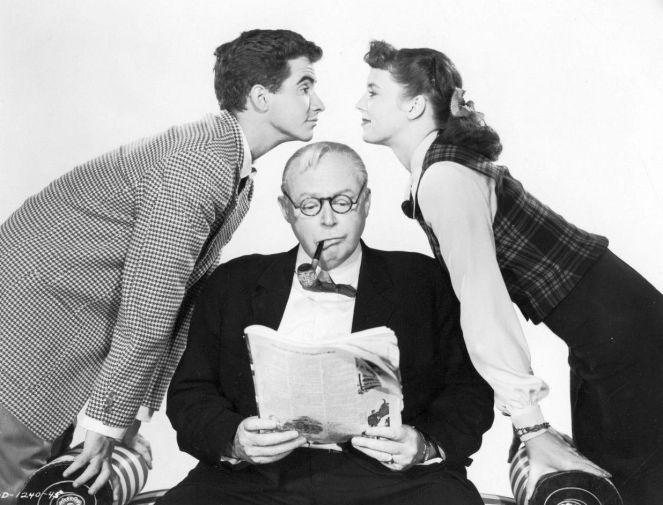
But I have to be honest: outside of the Our Gang shorts of the 1930s, Scotty Beckett was always an acquired taste for me. Beckett was a very underrated actor who appeared in a number of prestigious films once he finished his stint with the Gang including Anthony Adverse (1936) and Kings’ Row (1941), but he had limited appeal as he got older. (Again, this is just me—I have had classic movie fans tell me I’m just plain wrong.) Fortunately, there are enough great character veterans in Gasoline Alley—Dick Wessel, Gus Schilling (as an ex-con hired to work at Corky’s dive), Byron Foulger, Charles Halton, and Christine McIntyre (as a waitress named “Myrtle”)—to make me overlook this casting flaw.
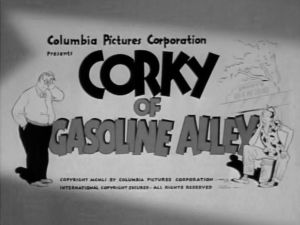 Leonard Maltin gives Gasoline Alley two-and-a-half stars in his Classic Movie Guide…but its follow-up, Corky of Gasoline Alley (1951), only rates two stars. The reason for this is the presence of Gordon Jones, “who’s so insufferable he all but sinks the film,” according to Len. I strongly disagree with this appraisal; I think Corky is actually an improvement over the first film because there’s a lot more physical comedy (both films were written and directed by comedy two-reeler veteran Edward Bernds, who had also worked on several of the Blondie features), giving it a bit more “oomph” than Gasoline Alley.
Leonard Maltin gives Gasoline Alley two-and-a-half stars in his Classic Movie Guide…but its follow-up, Corky of Gasoline Alley (1951), only rates two stars. The reason for this is the presence of Gordon Jones, “who’s so insufferable he all but sinks the film,” according to Len. I strongly disagree with this appraisal; I think Corky is actually an improvement over the first film because there’s a lot more physical comedy (both films were written and directed by comedy two-reeler veteran Edward Bernds, who had also worked on several of the Blondie features), giving it a bit more “oomph” than Gasoline Alley.
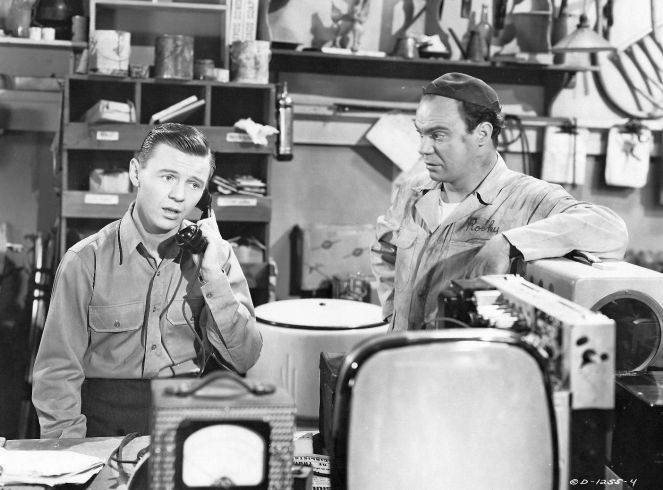
Is Gordon Jones insufferable? You betchum, Red Ryder—TV’s “Mike the Cop” plays Elwood Martin, Hope’s cousin and a 24-karat goldbricker who manages to ingratiate his way into the Wallet household despite Hope’s reservations. (Hope tells husband Corky that Elwood stayed with an uncle for six months until the house burned down and Elwood had to move…and several members of the family believe that Uncle burned the house down just to get rid of the four-flushing Elwood.) Martin is a braggart and liar (he reminds me a lot of the titular character in The Show-Off [1926]) who shows a brief bit of redemption when he demonstrates a proficiency for fixing TV sets (Skeezix’s partner in the fix-it shop advertised that they would take sets in need of repair…and then was recalled into the military, leaving Skeezix holding the bag). (After Cousin Elwood fixes one set, the 1948 Superman serial is apparently being aired on the local station—which was good for a snicker.) This doesn’t last long, sadly; Elwood fakes a back injury and for a moment appears as if he’s going to be a permanent resident.
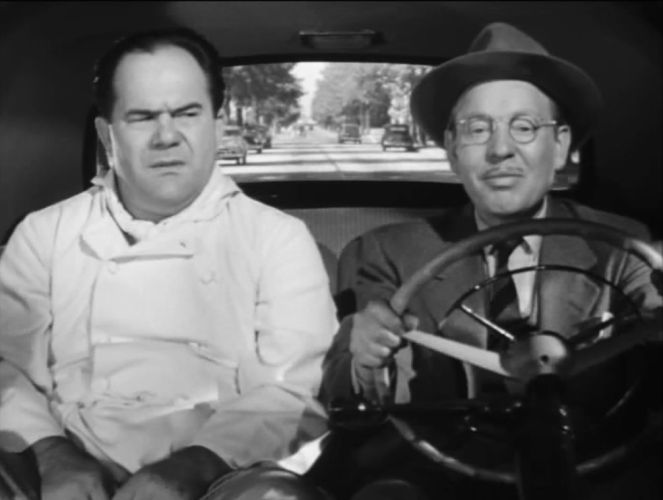
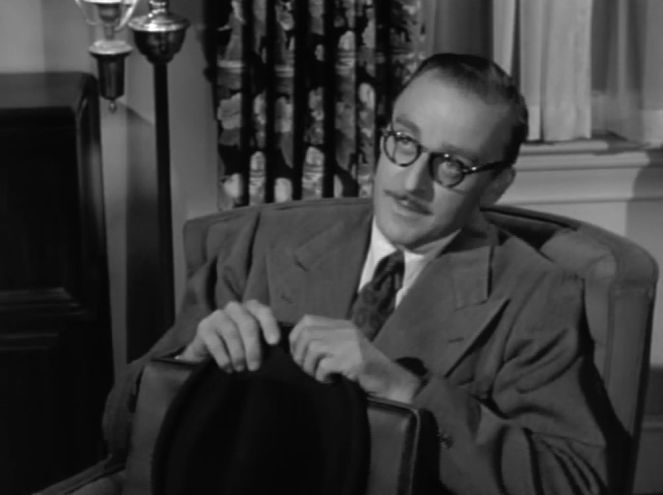
Jones eventually (and obnoxiously) wears out his welcome at Casa del Wallet, receiving a fitting comeuppance to boot by feature’s end. I just think Corky of Gasoline Alley is funnier and faster-paced; in addition, it allows a bit more screen time to the other characters (the first Alley is preoccupied with Corky and Hope and their martial squabbles, which kind of bogs down the film) plus it provides a nice showcase for performers like John Doucette (as Skeezix’s assistant), Jack Rice, Ludwig Stossel, Three Stooges foil Emil Sitka, and (drum roll please) MISTER John Dehner. The comic strip’s “Avery” is also on hand (played by Harry Tyler), as are Skeezix and Nina’s children, “Chipper” (Rudy Lee) and Clovia (Mimi Gibson). The critical consensus at the time sided with Leonard Maltin at the time (Variety called it “a relatively weak comedy”), and since the enthusiasm from theatergoers was of a similar stripe, Columbia elected not to make any more additional entries in the series.
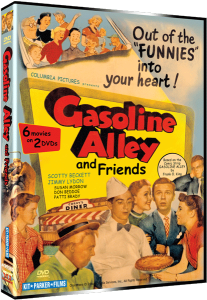 Both Gasoline Alley and Corky of Gasoline Alley might have vanished into the mist of classic movie obscurity were it not for our good friends at Kit Parker Films/The Sprocket Vault, who released the two features on a 2-DVD set, Gasoline Alley and Friends, in February of 2009. (Both films are paired with Robert L. Lippert features: Alley with the William Tracy-Joe Sawyer romps As You Were [1951] and Mr. Walkie Talkie [1952], Corky with Stop That Cab [1951] and Leave it to the Marines [1951]—both featuring Lippert “good luck charm” Sid Melton.) The collection is currently OOP, but you might be able to hunt down a copy on eBay…and who knows, with the celebration of Gasoline Alley’s centennial this November—maybe the company can be persuaded to bring it back for a limited run?
Both Gasoline Alley and Corky of Gasoline Alley might have vanished into the mist of classic movie obscurity were it not for our good friends at Kit Parker Films/The Sprocket Vault, who released the two features on a 2-DVD set, Gasoline Alley and Friends, in February of 2009. (Both films are paired with Robert L. Lippert features: Alley with the William Tracy-Joe Sawyer romps As You Were [1951] and Mr. Walkie Talkie [1952], Corky with Stop That Cab [1951] and Leave it to the Marines [1951]—both featuring Lippert “good luck charm” Sid Melton.) The collection is currently OOP, but you might be able to hunt down a copy on eBay…and who knows, with the celebration of Gasoline Alley’s centennial this November—maybe the company can be persuaded to bring it back for a limited run?
